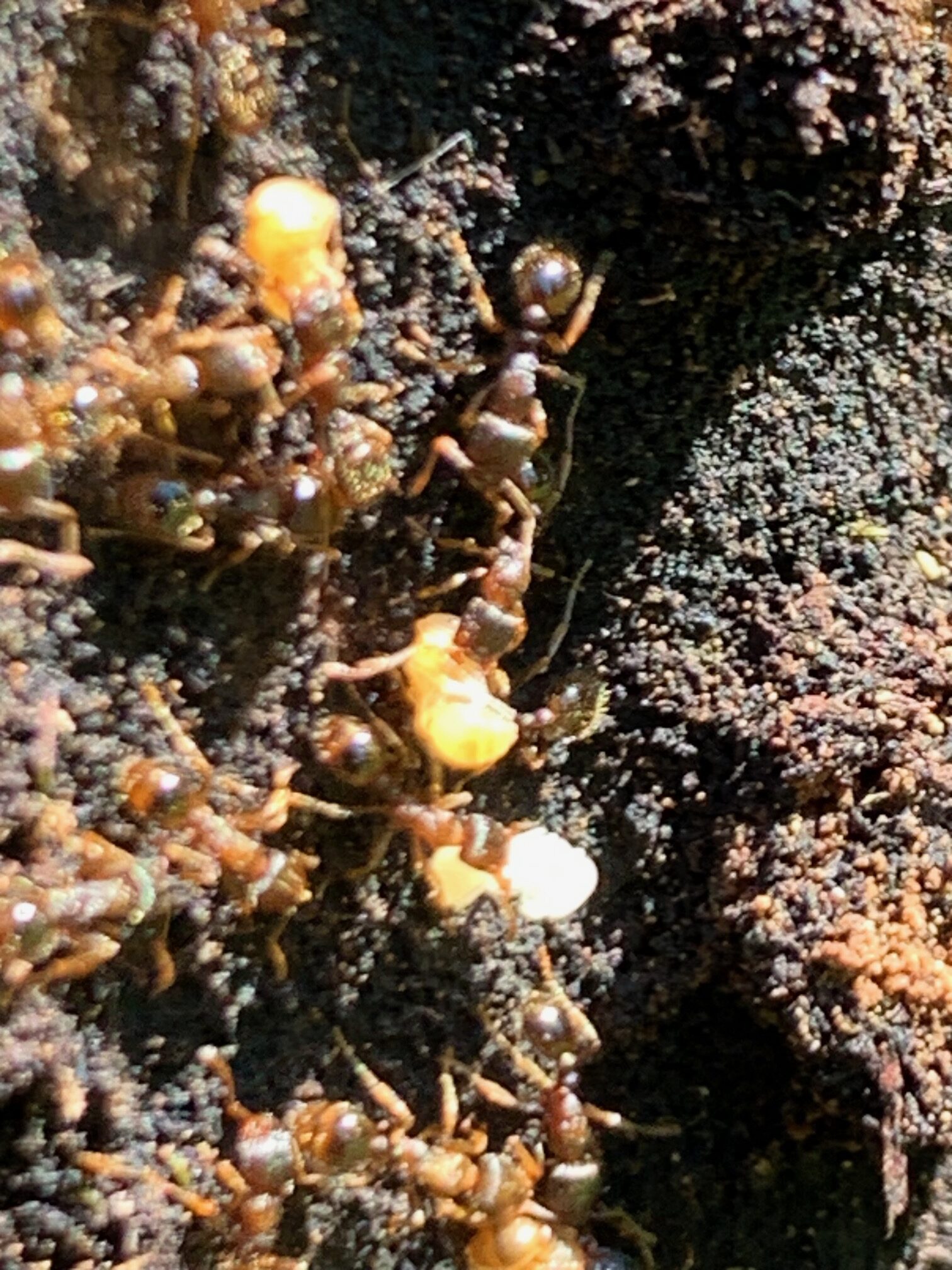When I built the house on Owl Acres 20 years ago, a walnut tree stood sentinel at the corner of the driveway. Unfortunately, as time went on, that tree began to lean more and more toward the garage. It had apparently been compromised by all the building activity. We decided to take the tree down, but rather than grind the stump into oblivion, we contracted Gary Keenan, a chainsaw sculptor, to create the owl sculpture that we have today.
He did a beautiful job, and the sculpture stands today about ten feet high. The bark was left on the stump, and eventually it became loose. One day this fall, Bryan removed it. To his chagrin, an entire colony of red ants came boiling out from under the bark, their home destroyed.

The scene of the crime. Photo by Author
Without sending samples of the ants to Iowa State for identification, it’s hard to tell exactly what species of ants we had living under that bark. My best guess is that they were a species of field ants native to the area (Formica spp).
World-wide, some 290 species of ants share the genus Formica, 97 species of which are native to North America and may be found on Owl Acres. Formica is the Latin word for ant, and the genus covers field, mound, thatching and wood ants. Each of these species has particular preferences on where they build their nests. Most species build their nests on the ground or in rotten wood. They build mounds from dirt and bits of plant material, and some mounds reach three feet or more across and up to two feet tall. Colonies of Formica ants can persist for ten years or more if undisturbed.
The 97 species of field ants that live in Iowa come in a variety of colors and sizes. They range from yellow and red to black and brown, depending on the species. Workers are usually from 4 to 8 millimeters long (a quarter to a third of an inch), and the breeding males and females are a bit bigger, up to 13 millimeters (half an inch). They are often confused with carpenter ants, but can be distinguished by the shape of their silhouettes. Carpenter ants look smoothly rounded in silhouette. Field ants in the Formica genus look a bit lumpy from the side.
Field ants don’t have stingers like bees. However, they do bite. To add insult to injury, they can spray formic acid from the tips of their abdomens onto the bite, making it sting like crazy.
Like most ants, they live in colonies, often with a single queen. An established queen lays thousands of eggs, and the worker ants decide when it’s time for new “reproductives,” that is males and females, to be produced. These chosen ones get a richer diet than the ordinary worker bees and develop into winged males and females. On a warm, humid summer day, preferably just after a nice rain, the winged males and females exit the nest. Depending on which species they are, either the females or the males will swarm or call, and their counterparts will come, led by the pheromones to the mating space. Males die a few days after frenetic mating. The females store all the sperm they collected for future use. Then they look for a suitable place to start building a new nest. Depending on what species they are, the nest might be a hole in the dirt, under rotting wood, or the beginnings of a mound. The female removes her wings—she will never fly again. Then she makes a start of the nest and begins laying eggs. She will nurture these first eggs herself into the first generation of worker ants. Once she has enough worker ants to take care of her and her offspring and to supply food for the nest, she will stop all activities except eating and laying eggs. If she is successful, her nest will grow over time as new workers make new tunnels and new chambers, using dirt and plant debris to build and build. The nest may persist for ten years or more, as long as the queen continues tapping into the sperm she gathered during her nuptial mating and laying eggs by the thousands. When she finally runs out, or is otherwise compromised, she will die, and the entire colony that she has presided over all this time will fall into disarray and eventually scatter and die.
Field ants generally have no interest in coming into the house. If they do stray in, it’s because they heard there was food there, but they don’t stay long. Their preferred food in many cases is honeydew—the sweet sticky stuff that aphids excrete. Some field ants will actually herd the aphids to optimal feeding areas so they can take advantage of the honeydew the aphids produce. Along with honeydew, field ants will eat a smorgasbord of plant and animal material. They will attack and kill or scavenge small arthropods or worms. They will also seek out nectar.
Formica ants are found throughout North America from the tundra to high-elevation tropics. On Owl Acres, they were trying to live peacefully under the dead tree bark before we disturbed them.
That particular colony may rebuild in a new location, possibly invading an existing colony. Or it may just scatter and disappear. Either way, these ants won’t move into the house.
Photo by Author. Alt text: It’s time for the bark to come off the owl tree sculpture. Thousands of red ants, each no more than 1/16-inch-long, are instantly cast into a desperate effort to save the cream yellow babies. Their home is gone, their society in tatters in the blink of an eye. The giant who destroyed their world pauses a moment to reflect on the enormity of the act he has just committed. He snaps a couple of photos and brushes away a few of the tiny creatures who are biting him.
